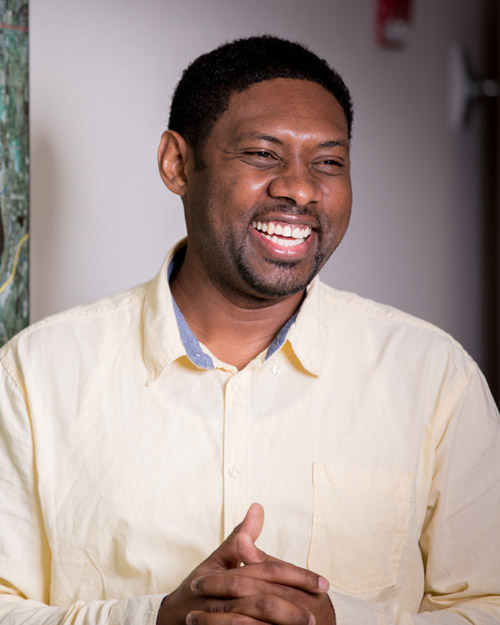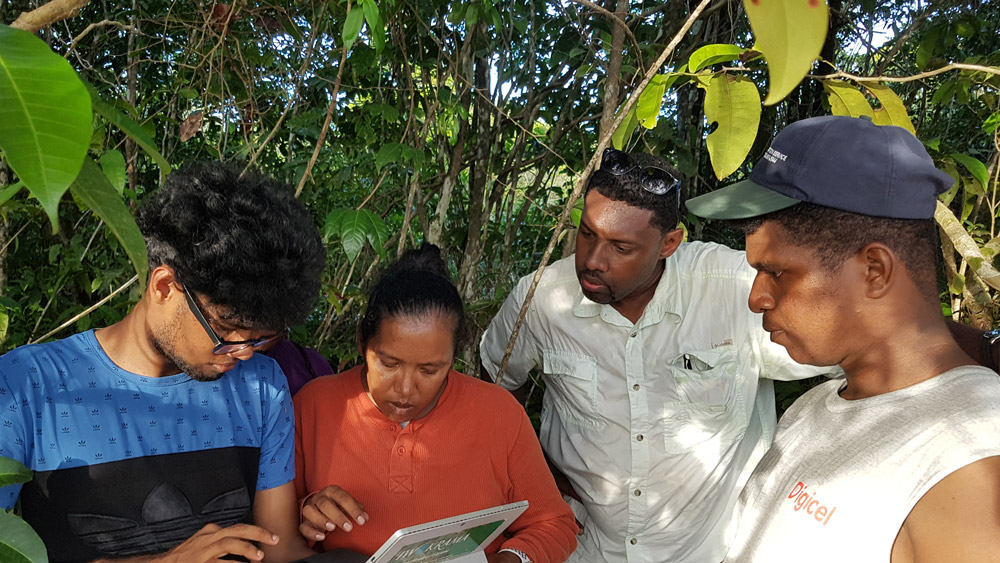Professor To Expand Landscape of Research with NSF CAREER Award
By: Brittany Magelssen | June 4, 2021

As a boy, Dr. Anthony Cummings walked the forests of Guyana. Raised among indigenous peoples near the Venezuela border, he noticed the ways they approached the land and made their livelihoods.
With a five-year, $523,000 grant from the National Science Foundation (NSF), Cummings will return to his home country to study indigenous peoples’ influenced landscapes, or landscapes within which indigenous peoples complete a range of traditional livelihood practices.
Cummings, an associate professor of geospatial information sciences (GIS) in the School of Economic, Political and Policy Sciences at The University of Texas at Dallas, earned a Faculty Early Career Development Program (CAREER) award for his project “Land-Use and Land-Cover Change Impact on Biodiversity and Indigenous Peoples’ Livelihoods.”
Through his research, Cummings aims to understand how forces that are seemingly far away from indigenous peoples’ influenced landscapes — such as fluctuations in the stock market or the demand for gold or timber — are interpreted by the people within those landscapes.
Learn More
Listen to Dr. Anthony Cummings discuss his research in an episode from the UT Dallas CometCast Network:
Could We Ever Understand the Importance of Tropical Landscapes?
“For example, if gold prices go up, does that mean there is a higher demand for gold within indigenous peoples’ influenced landscapes and that you have more people wanting to become gold miners?” Cummings asked. “Or, as more folks in China gain access to capital and there is a higher demand for exotic fruits, does that mean indigenous peoples’ farming spaces are now becoming production grounds for those fruits? And what does that mean for land cover in those spaces? Does it impact the amount of forest or the traditional ecosystem services that indigenous peoples may have derived from the forests?
“In other words, when there is a change someplace far away, can we begin to measure responses at these fine spatial scales of indigenous peoples’ farms and within their swidden [the cutting and burning of plants in a forest or woodland to create a field] landscapes?”

Cummings’ research team will develop novel approaches for obtaining imagery and mapping tropical forest cover using unoccupied aerial vehicles, or drones, and will examine the factors that determine changes in land use and land cover.
Various models have been developed to understand and explain change within tropical settings, but no scientific study has been completed at the level of indigenous peoples’ swidden landscapes, Cummings said.
A New Perspective
A parallel goal of the project is to introduce American students to these landscapes.
Through a summer field institute, Cummings plans to take four UT Dallas undergraduates to Guyana to interact with the indigenous Makushi people and learn about local ecology and geography. They will be exposed to the indigenous peoples’ farming practices and learn some of their language.
“You have lectures, and you have anecdotes, and you have illustrations that you use from the field. And students are fascinated by it and want to experience it in person. To know that I finally have the funding to do it, I’m elated.”
Dr. Anthony Cummings, an associate professor of geospatial information sciences in the School of Economic, Political and Policy Sciences
“You have lectures, and you have anecdotes, and you have illustrations that you use from the field. And students are fascinated by it and want to experience it in person,” he said. “To know that I finally have the funding to do it, I’m elated.”
Cummings views his students as future tropical scientists who will pursue scholarship in remote sensing, GIS and tropical ecology. They’re also future decision-makers, who will be better equipped to shape U.S. policy regarding migration and overseas direct investment.
Guyana’s economy is expected to grow substantially because of recent oil discoveries.
About CAREER Awards
The Faculty Early Career Development Program supports early-career faculty who exemplify the role of teacher-scholars through outstanding research and excellent education. The highly selective program is the National Science Foundation’s most prestigious award for early-career faculty who are considered likely to become leaders in their fields.
“I’m hoping by the end of the next five years, I’ll have a group of American scientists who are not only interested in the tropics as a research site, but who also begin to think through how their lives — which appear to be far removed from those tropical landscapes — are impacting what happens in those spaces,” Cummings said. “By being exposed to people who live within these spaces and understanding the forces that act within these spaces, the students I work with will be better informed. They will see the world from a different perspective.”
Cummings is most looking forward to working in closer collaboration with his indigenous colleagues. Soon, he plans to contact the local village leaders with a question they might not often receive: What can he do for them?
“It’s easy to go to a place, study people, publish papers about them, include them as collaborators on your papers and so on,” Cummings said. “What’s more difficult is being able to return to that space and add value to their lives as a researcher. How can I help these people to use the data, the knowledge and the skills that I’m bringing to improve their livelihoods? How do I leave that place and those people better off than I found them?”
Media Contact: Brittany Magelssen, UT Dallas, 972-883-4357, brittany.hoover@utdallas.edu, or the Office of Media Relations, UT Dallas, (972) 883-2155, newscenter@utdallas.edu.





